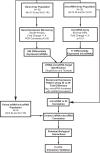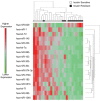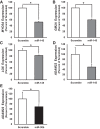Integrative mRNA-microRNA analyses reveal novel interactions related to insulin sensitivity in human adipose tissue
- PMID: 26672043
- PMCID: PMC4729698
- DOI: 10.1152/physiolgenomics.00071.2015
Integrative mRNA-microRNA analyses reveal novel interactions related to insulin sensitivity in human adipose tissue
Abstract
Adipose tissue has profound effects on whole-body insulin sensitivity. However, the underlying biological processes are quite complex and likely multifactorial. For instance, the adipose transcriptome is posttranscriptionally modulated by microRNAs, but the relationship between microRNAs and insulin sensitivity in humans remains to be determined. To this end, we utilized an integrative mRNA-microRNA microarray approach to identify putative molecular interactions that regulate the transcriptome in subcutaneous adipose tissue of insulin-sensitive (IS) and insulin-resistant (IR) individuals. Using the NanoString nCounter Human v1 microRNA Expression Assay, we show that 17 microRNAs are differentially expressed in IR vs. IS. Of these, 16 microRNAs (94%) are downregulated in IR vs. IS, including miR-26b, miR-30b, and miR-145. Using Agilent Human Whole Genome arrays, we identified genes that were predicted targets of miR-26b, miR-30b, and miR-145 and were upregulated in IR subjects. This analysis produced ADAM22, MYO5A, LOX, and GM2A as predicted gene targets of these microRNAs. We then validated that miR-145 and miR-30b regulate these mRNAs in differentiated human adipose stem cells. We suggest that use of bioinformatic integration of mRNA and microRNA arrays yields verifiable mRNA-microRNA pairs that are associated with insulin resistance and can be validated in vitro.
Keywords: adipose; insulin sensitivity; microRNA; microarray.
Copyright © 2016 the American Physiological Society.
Figures





Similar articles
-
MicroRNA-223 Expression is Upregulated in Insulin Resistant Human Adipose Tissue.J Diabetes Res. 2015;2015:943659. doi: 10.1155/2015/943659. Epub 2015 Jul 27. J Diabetes Res. 2015. PMID: 26273679 Free PMC article.
-
Adaptive expression of microRNA-125a in adipose tissue in response to obesity in mice and men.PLoS One. 2014 Mar 27;9(3):e91375. doi: 10.1371/journal.pone.0091375. eCollection 2014. PLoS One. 2014. PMID: 24675842 Free PMC article.
-
Low miR-222 expression in human visceral adipose tissue is associated with insulin resistance and PTEN and p53 mRNA levels.Endokrynol Pol. 2022;73(5):846-855. doi: 10.5603/EP.a2022.0057. Epub 2022 Aug 16. Endokrynol Pol. 2022. PMID: 35971931
-
Human adipose microRNA-221 is upregulated in obesity and affects fat metabolism downstream of leptin and TNF-α.Diabetologia. 2013 Sep;56(9):1971-9. doi: 10.1007/s00125-013-2950-9. Epub 2013 Jun 12. Diabetologia. 2013. PMID: 23756832 Free PMC article.
-
MicroRNAs in adipose tissue: their role in adipogenesis and obesity.Int J Obes (Lond). 2013 Mar;37(3):325-32. doi: 10.1038/ijo.2012.59. Epub 2012 Apr 24. Int J Obes (Lond). 2013. PMID: 22531086 Review.
Cited by
-
Extracellular vesicle transfer of miR-1 to adipose tissue modifies lipolytic pathways following resistance exercise.JCI Insight. 2024 Nov 8;9(21):e182589. doi: 10.1172/jci.insight.182589. JCI Insight. 2024. PMID: 39316445 Free PMC article.
-
No novel, high penetrant gene might remain to be found in Japanese patients with unknown MODY.J Hum Genet. 2018 Jul;63(7):821-829. doi: 10.1038/s10038-018-0449-4. Epub 2018 Apr 18. J Hum Genet. 2018. PMID: 29670293
-
MicroRNAs: The Link between the Metabolic Syndrome and Oncogenesis.Int J Mol Sci. 2021 Jun 13;22(12):6337. doi: 10.3390/ijms22126337. Int J Mol Sci. 2021. PMID: 34199293 Free PMC article. Review.
-
MicroRNA Expression Profiles in the Subcutaneous Adipose Tissues of Morbidly Obese Chinese Women.Obes Facts. 2021 Feb 5;14(1):1-15. doi: 10.1159/000511772. Online ahead of print. Obes Facts. 2021. PMID: 33550286 Free PMC article.
-
Developmental programming: Adipose depot-specific regulation of non-coding RNAs and their relation to coding RNA expression in prenatal testosterone and prenatal bisphenol-A -treated female sheep.Mol Cell Endocrinol. 2023 Mar 15;564:111868. doi: 10.1016/j.mce.2023.111868. Epub 2023 Jan 26. Mol Cell Endocrinol. 2023. PMID: 36708980 Free PMC article.
References
-
- Abbasi F, Brown BW Jr, Lamendola C, McLaughlin T, Reaven GM. Relationship between obesity, insulin resistance, and coronary heart disease risk. J Am Coll Cardiol 40: 937–943, 2002. - PubMed
-
- Bergman RN, Hope ID, Yang YJ, Watanabe RM, Meador MA, Youn JH, Ader M. Assessment of insulin sensitivity in vivo: a critical review. Diabetes Metab Rev 5: 411–429, 1989. - PubMed
-
- Bolger JC, Young LS. ADAM22 as a prognostic and therapeutic drug target in the treatment of endocrine-resistant breast cancer. Vitam Horm 93: 307–321, 2013. - PubMed
-
- Bork-Jensen J, Thuesen AC, Bang-Bertelsen CH, Grunnet LG, Pociot F, Beck-Nielsen H, Ozanne SE, Poulsen P, Vaag A. Genetic versus non-genetic regulation of miR-103, miR-143 and miR-483-3p expression in adipose tissue and their metabolic implications–a twin study. Genes 5: 508–517, 2014. - PMC - PubMed
Publication types
MeSH terms
Substances
Grants and funding
LinkOut - more resources
Full Text Sources
Other Literature Sources
Medical

